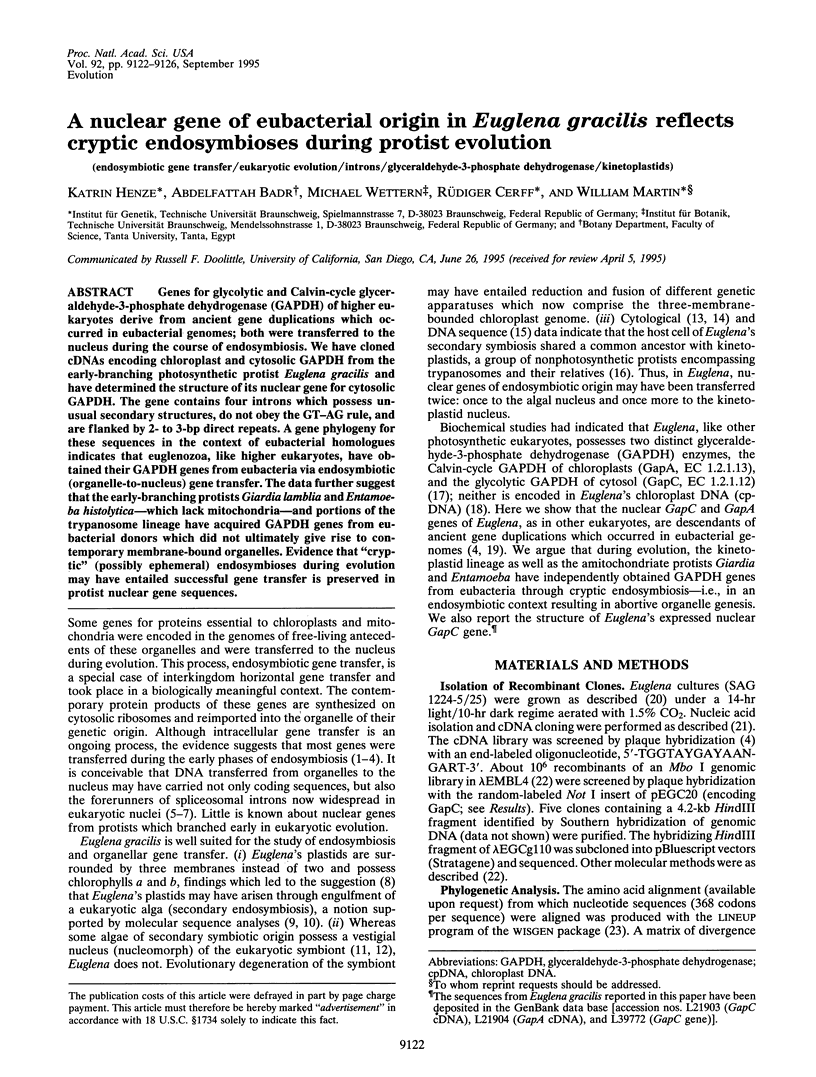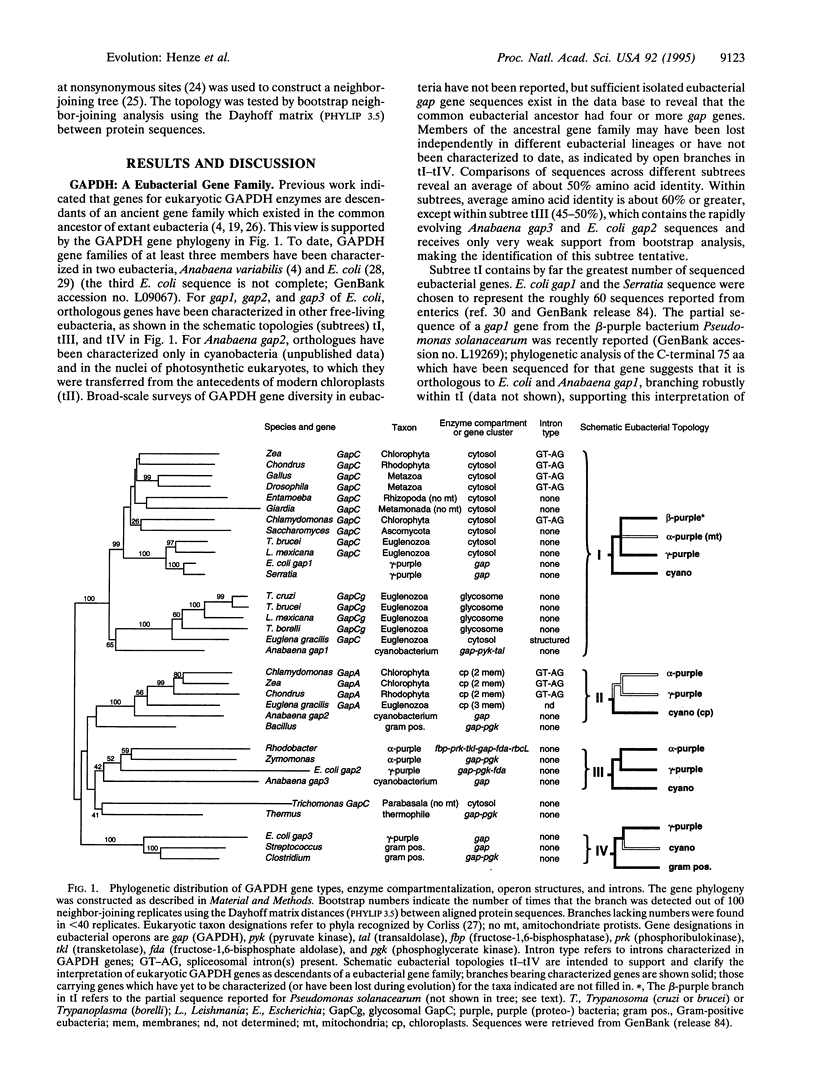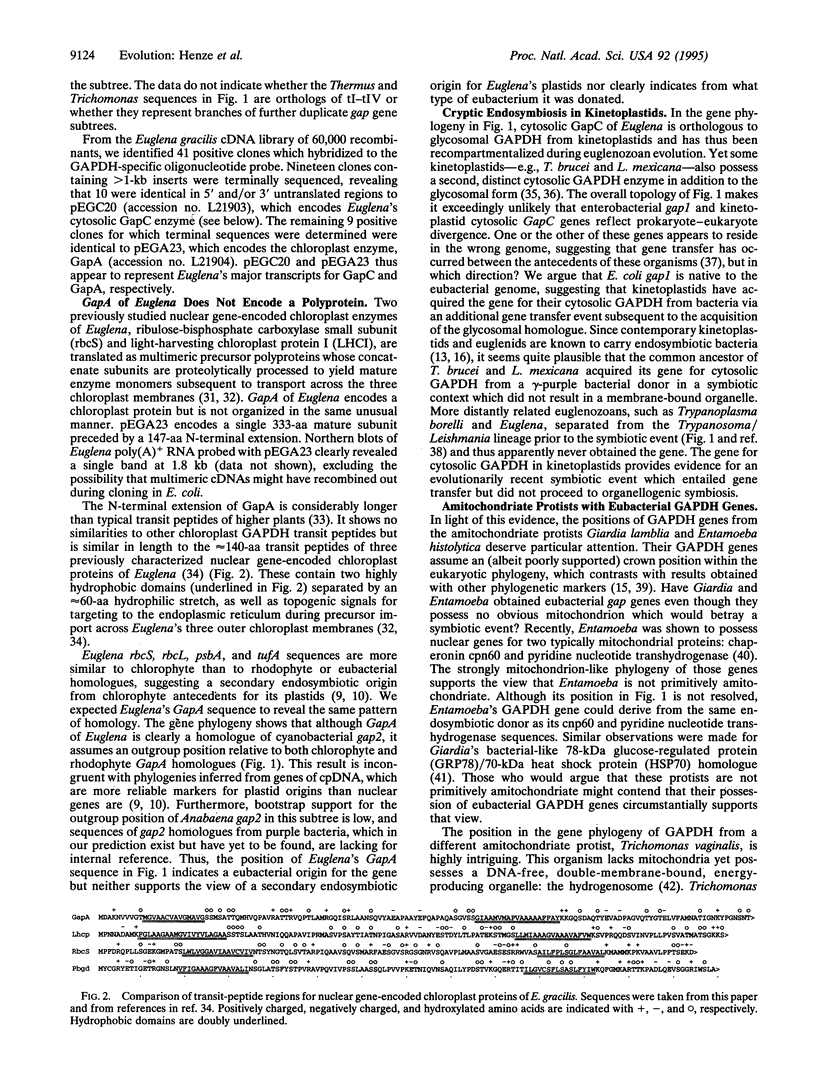Abstract
Genes for glycolytic and Calvin-cycle glyceraldehyde-3-phosphate dehydrogenase (GAPDH) of higher eukaryotes derive from ancient gene duplications which occurred in eubacterial genomes; both were transferred to the nucleus during the course of endosymbiosis. We have cloned cDNAs encoding chloroplast and cytosolic GAPDH from the early-branching photosynthetic protist Euglena gracilis and have determined the structure of its nuclear gene for cytosolic GAPDH. The gene contains four introns which possess unusual secondary structures, do not obey the GT-AG rule, and are flanked by 2- to 3-bp direct repeats. A gene phylogeny for these sequences in the context of eubacterial homologues indicates that euglenozoa, like higher eukaryotes, have obtained their GAPDH genes from eubacteria via endosymbiotic (organelle-to-nucleus) gene transfer. The data further suggest that the early-branching protists Giardia lamblia and Entamoeba histolytica--which lack mitochondria--and portions of the trypanosome lineage have acquired GAPDH genes from eubacterial donors which did not ultimately give rise to contemporary membrane-bound organelles. Evidence that "cryptic" (possibly ephemeral) endosymbioses during evolution may have entailed successful gene transfer is preserved in protist nuclear gene sequences.
Full text
PDF




Selected References
These references are in PubMed. This may not be the complete list of references from this article.
- Alefounder P. R., Perham R. N. Identification, molecular cloning and sequence analysis of a gene cluster encoding the class II fructose 1,6-bisphosphate aldolase, 3-phosphoglycerate kinase and a putative second glyceraldehyde 3-phosphate dehydrogenase of Escherichia coli. Mol Microbiol. 1989 Jun;3(6):723–732. doi: 10.1111/j.1365-2958.1989.tb00221.x. [DOI] [PubMed] [Google Scholar]
- Baldauf S. L., Palmer J. D. Evolutionary transfer of the chloroplast tufA gene to the nucleus. Nature. 1990 Mar 15;344(6263):262–265. doi: 10.1038/344262a0. [DOI] [PubMed] [Google Scholar]
- Branlant G., Branlant C. Nucleotide sequence of the Escherichia coli gap gene. Different evolutionary behavior of the NAD+-binding domain and of the catalytic domain of D-glyceraldehyde-3-phosphate dehydrogenase. Eur J Biochem. 1985 Jul 1;150(1):61–66. doi: 10.1111/j.1432-1033.1985.tb08988.x. [DOI] [PubMed] [Google Scholar]
- Cech T. R. Self-splicing of group I introns. Annu Rev Biochem. 1990;59:543–568. doi: 10.1146/annurev.bi.59.070190.002551. [DOI] [PubMed] [Google Scholar]
- Chan R. L., Keller M., Canaday J., Weil J. H., Imbault P. Eight small subunits of Euglena ribulose 1-5 bisphosphate carboxylase/oxygenase are translated from a large mRNA as a polyprotein. EMBO J. 1990 Feb;9(2):333–338. doi: 10.1002/j.1460-2075.1990.tb08115.x. [DOI] [PMC free article] [PubMed] [Google Scholar]
- Clark C. G., Roger A. J. Direct evidence for secondary loss of mitochondria in Entamoeba histolytica. Proc Natl Acad Sci U S A. 1995 Jul 3;92(14):6518–6521. doi: 10.1073/pnas.92.14.6518. [DOI] [PMC free article] [PubMed] [Google Scholar]
- Copertino D. W., Shigeoka S., Hallick R. B. Chloroplast group III twintron excision utilizing multiple 5'- and 3'-splice sites. EMBO J. 1992 Dec;11(13):5041–5050. doi: 10.1002/j.1460-2075.1992.tb05611.x. [DOI] [PMC free article] [PubMed] [Google Scholar]
- Devereux J., Haeberli P., Smithies O. A comprehensive set of sequence analysis programs for the VAX. Nucleic Acids Res. 1984 Jan 11;12(1 Pt 1):387–395. doi: 10.1093/nar/12.1part1.387. [DOI] [PMC free article] [PubMed] [Google Scholar]
- Doolittle R. F., Feng D. F., Anderson K. L., Alberro M. R. A naturally occurring horizontal gene transfer from a eukaryote to a prokaryote. J Mol Evol. 1990 Nov;31(5):383–388. doi: 10.1007/BF02106053. [DOI] [PubMed] [Google Scholar]
- Doolittle R. F. Of archae and eo: what's in a name? Proc Natl Acad Sci U S A. 1995 Mar 28;92(7):2421–2423. doi: 10.1073/pnas.92.7.2421. [DOI] [PMC free article] [PubMed] [Google Scholar]
- Ferat J. L., Michel F. Group II self-splicing introns in bacteria. Nature. 1993 Jul 22;364(6435):358–361. doi: 10.1038/364358a0. [DOI] [PubMed] [Google Scholar]
- Gantt J. S., Baldauf S. L., Calie P. J., Weeden N. F., Palmer J. D. Transfer of rpl22 to the nucleus greatly preceded its loss from the chloroplast and involved the gain of an intron. EMBO J. 1991 Oct;10(10):3073–3078. doi: 10.1002/j.1460-2075.1991.tb07859.x. [DOI] [PMC free article] [PubMed] [Google Scholar]
- Gupta R. S., Aitken K., Falah M., Singh B. Cloning of Giardia lamblia heat shock protein HSP70 homologs: implications regarding origin of eukaryotic cells and of endoplasmic reticulum. Proc Natl Acad Sci U S A. 1994 Apr 12;91(8):2895–2899. doi: 10.1073/pnas.91.8.2895. [DOI] [PMC free article] [PubMed] [Google Scholar]
- Hallick R. B., Hong L., Drager R. G., Favreau M. R., Monfort A., Orsat B., Spielmann A., Stutz E. Complete sequence of Euglena gracilis chloroplast DNA. Nucleic Acids Res. 1993 Jul 25;21(15):3537–3544. doi: 10.1093/nar/21.15.3537. [DOI] [PMC free article] [PubMed] [Google Scholar]
- Hannaert V., Blaauw M., Kohl L., Allert S., Opperdoes F. R., Michels P. A. Molecular analysis of the cytosolic and glycosomal glyceraldehyde-3-phosphate dehydrogenase in Leishmania mexicana. Mol Biochem Parasitol. 1992 Oct;55(1-2):115–126. doi: 10.1016/0166-6851(92)90132-4. [DOI] [PubMed] [Google Scholar]
- Hashimoto T., Nakamura Y., Nakamura F., Shirakura T., Adachi J., Goto N., Okamoto K., Hasegawa M. Protein phylogeny gives a robust estimation for early divergences of eukaryotes: phylogenetic place of a mitochondria-lacking protozoan, Giardia lamblia. Mol Biol Evol. 1994 Jan;11(1):65–71. doi: 10.1093/oxfordjournals.molbev.a040093. [DOI] [PubMed] [Google Scholar]
- Henze K., Schnarrenberger C., Kellermann J., Martin W. Chloroplast and cytosolic triosephosphate isomerases from spinach: purification, microsequencing and cDNA cloning of the chloroplast enzyme. Plant Mol Biol. 1994 Dec;26(6):1961–1973. doi: 10.1007/BF00019506. [DOI] [PubMed] [Google Scholar]
- Houlné G., Schantz R. Characterization of cDNA sequences for LHCI apoproteins in Euglena gracilis: the mRNA encodes a large precursor containing several consecutive divergent polypeptides. Mol Gen Genet. 1988 Aug;213(2-3):479–486. doi: 10.1007/BF00339619. [DOI] [PubMed] [Google Scholar]
- Kersanach R., Brinkmann H., Liaud M. F., Zhang D. X., Martin W., Cerff R. Five identical intron positions in ancient duplicated genes of eubacterial origin. Nature. 1994 Jan 27;367(6461):387–389. doi: 10.1038/367387a0. [DOI] [PubMed] [Google Scholar]
- Kishore R., Muchhal U. S., Schwartzbach S. D. The presequence of Euglena LHCPII, a cytoplasmically synthesized chloroplast protein, contains a functional endoplasmic reticulum-targeting domain. Proc Natl Acad Sci U S A. 1993 Dec 15;90(24):11845–11849. doi: 10.1073/pnas.90.24.11845. [DOI] [PMC free article] [PubMed] [Google Scholar]
- Maier U. G. The four genomes of the alga Pyrenomonas salina (Cryptophyta). Biosystems. 1992;28(1-3):69–73. doi: 10.1016/0303-2647(92)90009-n. [DOI] [PubMed] [Google Scholar]
- Markos A., Miretsky A., Müller M. A glyceraldehyde-3-phosphate dehydrogenase with eubacterial features in the amitochondriate eukaryote, Trichomonas vaginalis. J Mol Evol. 1993 Dec;37(6):631–643. doi: 10.1007/BF00182749. [DOI] [PubMed] [Google Scholar]
- Martin W., Brinkmann H., Savonna C., Cerff R. Evidence for a chimeric nature of nuclear genomes: eubacterial origin of eukaryotic glyceraldehyde-3-phosphate dehydrogenase genes. Proc Natl Acad Sci U S A. 1993 Sep 15;90(18):8692–8696. doi: 10.1073/pnas.90.18.8692. [DOI] [PMC free article] [PubMed] [Google Scholar]
- McFadden G. I., Gilson P. R., Hofmann C. J., Adcock G. J., Maier U. G. Evidence that an amoeba acquired a chloroplast by retaining part of an engulfed eukaryotic alga. Proc Natl Acad Sci U S A. 1994 Apr 26;91(9):3690–3694. doi: 10.1073/pnas.91.9.3690. [DOI] [PMC free article] [PubMed] [Google Scholar]
- Meyer-Gauen G., Schnarrenberger C., Cerff R., Martin W. Molecular characterization of a novel, nuclear-encoded, NAD(+)-dependent glyceraldehyde-3-phosphate dehydrogenase in plastids of the gymnosperm Pinus sylvestris L. Plant Mol Biol. 1994 Nov;26(4):1155–1166. doi: 10.1007/BF00040696. [DOI] [PubMed] [Google Scholar]
- Michel F., Umesono K., Ozeki H. Comparative and functional anatomy of group II catalytic introns--a review. Gene. 1989 Oct 15;82(1):5–30. doi: 10.1016/0378-1119(89)90026-7. [DOI] [PubMed] [Google Scholar]
- Michels P. A., Marchand M., Kohl L., Allert S., Wierenga R. K., Opperdoes F. R. The cytosolic and glycosomal isoenzymes of glyceraldehyde-3-phosphate dehydrogenase in Trypanosoma brucei have a distant evolutionary relationship. Eur J Biochem. 1991 Jun 1;198(2):421–428. doi: 10.1111/j.1432-1033.1991.tb16031.x. [DOI] [PubMed] [Google Scholar]
- Morden C. W., Delwiche C. F., Kuhsel M., Palmer J. D. Gene phylogenies and the endosymbiotic origin of plastids. Biosystems. 1992;28(1-3):75–90. doi: 10.1016/0303-2647(92)90010-v. [DOI] [PubMed] [Google Scholar]
- Muchhal U. S., Schwartzbach S. D. Characterization of a Euglena gene encoding a polyprotein precursor to the light-harvesting chlorophyll a/b-binding protein of photosystem II. Plant Mol Biol. 1992 Jan;18(2):287–299. doi: 10.1007/BF00034956. [DOI] [PubMed] [Google Scholar]
- Müller M. Energy metabolism of protozoa without mitochondria. Annu Rev Microbiol. 1988;42:465–488. doi: 10.1146/annurev.mi.42.100188.002341. [DOI] [PubMed] [Google Scholar]
- Nei M., Gojobori T. Simple methods for estimating the numbers of synonymous and nonsynonymous nucleotide substitutions. Mol Biol Evol. 1986 Sep;3(5):418–426. doi: 10.1093/oxfordjournals.molbev.a040410. [DOI] [PubMed] [Google Scholar]
- Nelson K., Whittam T. S., Selander R. K. Nucleotide polymorphism and evolution in the glyceraldehyde-3-phosphate dehydrogenase gene (gapA) in natural populations of Salmonella and Escherichia coli. Proc Natl Acad Sci U S A. 1991 Aug 1;88(15):6667–6671. doi: 10.1073/pnas.88.15.6667. [DOI] [PMC free article] [PubMed] [Google Scholar]
- Roger A. J., Doolittle W. F. Molecular evolution. Why introns-in-pieces? Nature. 1993 Jul 22;364(6435):289–290. doi: 10.1038/364289a0. [DOI] [PubMed] [Google Scholar]
- Saitou N., Nei M. The neighbor-joining method: a new method for reconstructing phylogenetic trees. Mol Biol Evol. 1987 Jul;4(4):406–425. doi: 10.1093/oxfordjournals.molbev.a040454. [DOI] [PubMed] [Google Scholar]
- Sogin M. L., Gunderson J. H., Elwood H. J., Alonso R. A., Peattie D. A. Phylogenetic meaning of the kingdom concept: an unusual ribosomal RNA from Giardia lamblia. Science. 1989 Jan 6;243(4887):75–77. doi: 10.1126/science.2911720. [DOI] [PubMed] [Google Scholar]
- Stoltzfus A., Spencer D. F., Zuker M., Logsdon J. M., Jr, Doolittle W. F. Testing the exon theory of genes: the evidence from protein structure. Science. 1994 Jul 8;265(5169):202–207. doi: 10.1126/science.8023140. [DOI] [PubMed] [Google Scholar]
- Tessier L. H., Paulus F., Keller M., Vial C., Imbault P. Structure and expression of Euglena gracilis nuclear rbcS genes encoding the small subunits of the ribulose 1,5-bisphosphate carboxylase/oxygenase: a novel splicing process for unusual intervening sequences? J Mol Biol. 1995 Jan 6;245(1):22–33. doi: 10.1006/jmbi.1994.0003. [DOI] [PubMed] [Google Scholar]
- Weeden N. F. Genetic and biochemical implications of the endosymbiotic origin of the chloroplast. J Mol Evol. 1981;17(3):133–139. doi: 10.1007/BF01733906. [DOI] [PubMed] [Google Scholar]
- Wiemer E. A., Hannaert V., van den IJssel P. R., Van Roy J., Opperdoes F. R., Michels P. A. Molecular analysis of glyceraldehyde-3-phosphate dehydrogenase in Trypanoplasma borelli: an evolutionary scenario of subcellular compartmentation in kinetoplastida. J Mol Evol. 1995 Apr;40(4):443–454. doi: 10.1007/BF00164030. [DOI] [PubMed] [Google Scholar]


